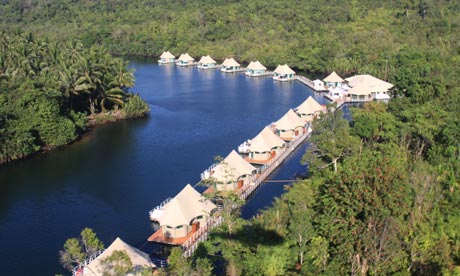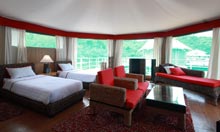
Four Rivers Lodge on its idyllic bend in the Tatai.
It's pitch black as I set off tentatively in my kayak, the starless sky merging seamlessly into the inky river. The only sound is of my paddle in the water and a faint chirping of cicadas. Suddenly the darkness is broken – a tree decorated in a thousand fairy lights is frantically flickering on the riverbank.
"It's the firefly disco," says Chilly, my guide, pointing at the twinkling display.
I am, it's fair to say, in the middle of nowhere. This is the Tatai river, east of Koh Kong, in the southern reaches of Cambodia's Cardamom mountains. Half-way between Bangkok and Phnom Penh, this is a pristine area of rainforest and coastal mangroves that barely features on the tourist trail.
What's more I'm camping – though it's not exactly pop-up tent and baked beans. I'm staying at the Four Rivers Floating Lodge, which takes glamping to a whole new extreme.
 The spacious tents at Four Rivers.
The spacious tents at Four Rivers.
The brilliant idea of Romanian owner Valentin Pawlik, the entire resort is waterborne. You get here by boat, arriving at one of a series of floating wooden platforms. A central pontoon houses bar, restaurant and library. There are 12 huge and super-luxurious South African safari tents (six more are planned), with private decks and sunloungers, double-sinked en suite bathrooms, and flatscreen TVs and DVD players that seem a tad incongruous in the heart of the jungle. But, hey, this is wilderness in style.
It's all very eco-friendly too – largely solar-powered, and staffed mostly by locals – so you needn't have a guilty conscience. Move it away and there'd be little sign that it had ever existed.

Most visitors to Cambodia flock to the revitalised capital of Phnom Penh further east, and the temples around Siem Reap in the north. This coastal region, part of the Koh Kong Conservation Corridor, is home to some of the country's most impressive natural sights. The long civil war kept developers and loggers at bay, and the potential for ecotourism is huge (although the threat of hydroelectric power plants looms).

There are excursions into the jungle, led by a former poacher, to spot wildlife and to visit villages and fruit plantations (overnight camping is a new option too). As I'm here at the end of the rainy season, when leeches and mud make trekking treacherous, we take a boat downstream instead. Thick mangrove forests line the banks, and dolphins can sometimes be spied in the estuary opening on to the Gulf of Thailand. Koh Kong island appears on the horizon, an as yet undeveloped paradise with pristine beaches and untouched rainforest.

No comments:
Post a Comment